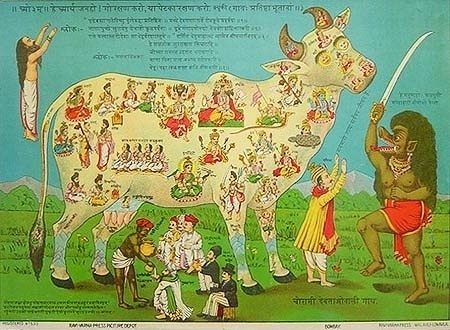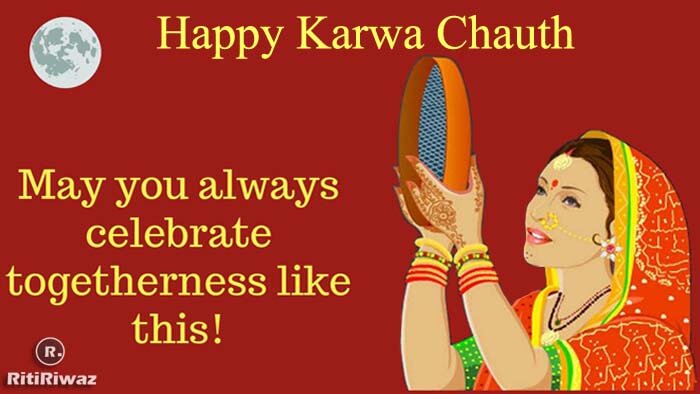Why Cow in India are Considered Holy Animal?

Sacred Cow or Holy Cow is used in Hinduism to honor cows. In Hinduism Cow is deeply respected, Hindus worship cows and rely heavily on cows for dairy products, for tilling fields, and for dung as a source of fuel and fertilizer.
A cow is honored and garlanded and given special feedings at many festivals. A cow is considered to be very gentle in nature and they give milk and cream, yogurt and cheese, butter and ice cream, and ghee. The milk of a cow is believed to refine a person. The ghee (clarified butter) from the milk is used in ceremonies and in preparing religious food. Cow dung is used as fertilizer, as a fuel, and as a disinfectant in homes.
The cow’s status as a ‘caretaker’ led to identifying it as an almost maternal figure (hence the term gau mata). The cow has been a symbol of wealth since ancient days. Religious Hindu households always had a cow in their backyard until a couple of decades ago. They provided the family’s daily:
- Food (milk, buttermilk, curd, butter, and ghee)
- Products for worship (ghee)
- Fuel for the kitchen (cow dung)
- Antiseptic cleaning agent (cow dung and cow urine)
- Clearing up extra growth in the farm before sowing.
A cow is sacred not only in Hinduism but in all old non-Abrahamic religions whether it is Jainism, Zoroastrianism, Ancient Middle-east religions as well as Greek and Roman religions. The reasons can be categorized as:
-
DOMESTICATION AND USES
A cow was extremely useful in the ancient period while buffalo was yet to be tamed.
-
MILK
First of all, Cow’s milk was the staple drink of the ancient people. Cow’s milk is closer in composition to human milk than buffalo’s milk, it was usually given to infants when mothers found it tough to wean.
Cow’s milk is a good source of Vitamin D, Riboflavin, Vitamin B12, Proteins, Calcium, Sugar, fatty acids and Phosphorus and also provided water, this was a balanced diet in itself.
Yogurt, Cheese, Butter, Paneer, Ghee (Clarified butter), Buttermilk, and milk-based confectioneries were first made and widely used in the ancient period.
-
DUNG
Cow’s dung is one of the most comprehensive natural manures. It was especially popular in the agro-oriented society of riverine India.
Caked and dried cow dung was used as fuel. Burned cow dung was used to repel mosquitoes. During cold months, cow dung was used to line the walls of the houses as a thermal insulator.
Fresh cow dung, cow urine, and crushed neem leaves were mixed with water and sprayed on crops and in front of the houses as an insecticide.
-
URINE
Gomutra or Fresh Cow’s Urine ( all flower water) was used as a medicine to treat a variety of ailments including gout, rheumatism, epilepsy, and tuberculosis.
It was used to dilute medical tinctures. It was used in Panchagavya cosmetics, a primitive method of clearing the complexion, and Concentrated Gomutra was also used as a floor cleaning fluid.
-
HIDE
A cow has been praised as the mother who helps even in death since her hide was used to make leather. Thus cow had a plethora of uses in the Ancient period. A Vedic poem calls a cow ” The Divine Mother, O Dhenu! who gives everything and asks nothing“, this aspect of all-giving was the root basis of the maternal personification of a cow.
On the other hand, early ancient people had not domesticated buffalo. A cow was domesticated in the Indus Valley region circa 10,500 years ago and was an essential part of their agrarian economy.
In comparison, Buffalo has domesticated in India only about 5,000 years ago. Thus while the cow was a docile and motherly domestic animal, buffalo was yet to become widespread. It was a troublesome animal and associated with death since wild buffaloes did more harm than good.
They spoiled cropped land, overgrazed the pastures, killed the people who tried to tame and wreaked total havoc. But those who were domesticated did do good, so Buffalo was sacred yet ghastly.
-
HUNTING
While Vedic kings restrained themselves from killing their domestic animals and pets, they were honor-bound to eat the game they hunt. Hence, a cow a domestic animal was not eaten while buffalo a wild forest animal was a hunt and thus at times eaten.






